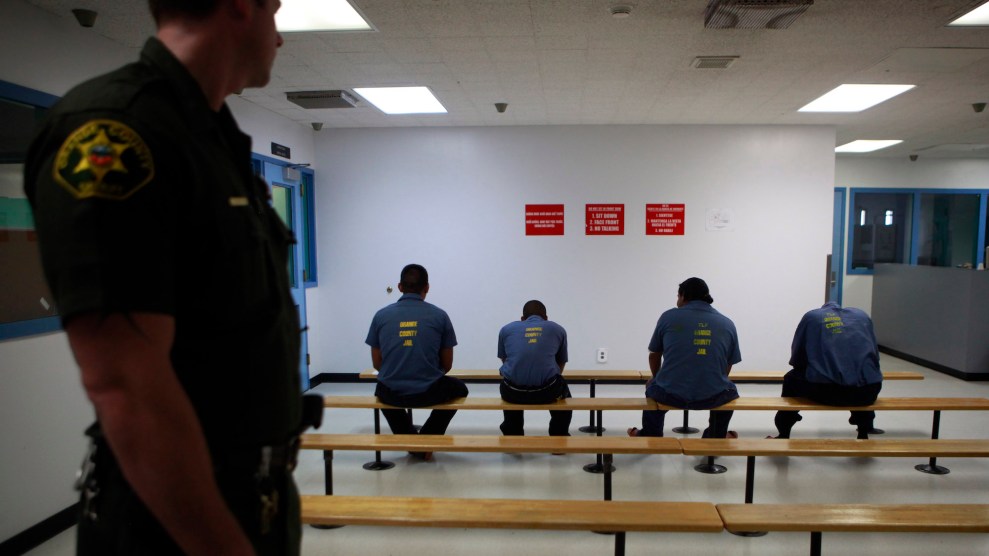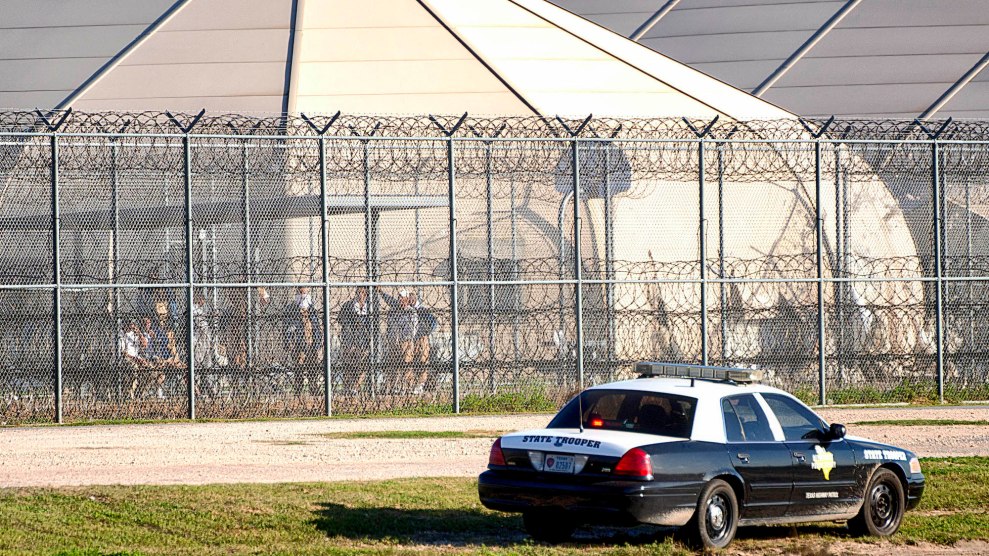
An Orange County Sheriff's deputy watches over immigration detainees at the Theo Lacy Facility.Jae C. Hong/AP
When federal inspectors stopped by the Theo Lacy Facility in Orange County, California, for a surprise check-in last November, they found spoiled meat and broken telephones, showers laced with mold, and immigrants held in solitary confinement for 24 hours a day. That’s according to a horrific report released Monday by the Department of Homeland Security’s Office of Inspector General, laying out serious health and safety risks for detained immigrants held in the facility.
The 3,442-bed jail holds convicted criminals, but its operator, the Orange County Sheriff’s Department, also has a contract with Immigration and Customs Enforcement (ICE) to incarcerate detained immigrants—around 478 people at the time of the inspection. The detainees, many of whom have never been convicted of a crime, are held while they await deportation or for a hearing to determine their legal status.
Here’s what the OIG watchdogs found:
- 24-hour solitary confinement: Detainees who broke facility rules were placed in Special Management Unit, “commonly known as solitary confinement,” according to the report. There they were confined to a cell for 24 hours a day, without access to visitors, recreation, a telephone, or religious services. They were allowed one book for their stay, which could last up to 30 days in total.
- Spoiled food: When inspectors stopped by the kitchen, they found “spoiled, foul-smelling” lunch meat about to be served to detainees that day. According to their interviews, it wasn’t a one-time occurrence: “Detainees reported being repeatedly served lunch meat that smelled and tasted bad, which they rinsed with water before eating,” inspectors wrote. Other meat was stored without an expiration date on the label or kept uncovered in walk-in refrigerators.
- Poor sanitation: Showers in two housing units contained trash, mildew, or mold. Detainees were also required to clean the shower stalls in their housing unit common areas, a violation of ICE standards, the report found. To do so, they were only given a scrub brush and all-purpose cleaner, “which does not combat mold and mildew,” inspectors noted.
- “High-risk” and “low-risk” detainees were housed together: ICE required the Orange County Sheriff’s Department to classify each detainee by “security risk,” based on past criminal convictions, immigration violations, and other factors, and assign them housing according to their classification level. But inspectors found that at Theo Lacy, “high-risk” detainees were housed in the least restrictive barracks while others, classified as “medium/low risk,” were put in more restrictive housing. Meanwhile, immigrants given different security classifications mixed freely. “This type of mingling…skirts the ICE detention standards’ prohibition, which is designed to ‘protect the community, staff, contractors, volunteers, and detainees from harm,'” inspectors wrote.
- Broken telephones: Phones that were supposed to be available for immigrants’ use did not work in three different housing units. On others, the volume of the call was so low that detainees couldn’t use the phones at all—restricting their ability to call family members or lawyers.
- Faulty grievance procedures: ICE and the Orange County Sheriff’s Department failed to adequately document or track detainees’ grievances to ensure they were resolved. Even if their grievance was resolved, detainees were not given the chance to appeal the decision.
This isn’t the first time people have complained of poor conditions at Theo Lacy. In 2012, the Detention Watch Network—an advocacy group that opposes immigration detention—released a report alleging that immigrants were subjected to physical and psychological abuse by staff, among other complaints. Immigration detainees in the facility have gone on hunger strike twice in the past two years to protest the poor conditions. But the OIG report is particularly noteworthy because it drops at a time when President Donald Trump has ordered ICE to expand its immigration detention capacity—putting more immigrants behind bars in local jails like Theo Lacy.
You can read the full OIG report, which also lays out ICE’s plans to fix conditions at the facility, here.













